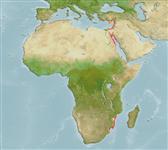Callistoctopus macropus (Risso, 1826)
White-spotted octopus| Native range | All suitable habitat | Point map | Year 2050 |

|
| This map was computer-generated and has not yet been reviewed. |
| Callistoctopus macropus AquaMaps Data sources: GBIF OBIS |
Classification / Names Common names | Synonyms | CoL | ITIS | WoRMS
| Octopoda | Octopodidae | Octopodinae
Environment: milieu / climate zone / depth range / distribution range экология
; пределы глубины 1 - 100 m (Ref. 83938). Tropical; 46°N - 30°S, 32°E - 37°E (Ref. 275)
распространение страны | регионы FAO | Ecosystems | места находок | интродукции
Circumglobal in warm to temperate waters.
Length at first maturity / Size / Вес / Возраст
Maturity: Lm ? range ? - ? cm Max length : 18.0 cm ML самец/пол неопределен; (Ref. 105659); common length : 80.0 cm TL самец/пол неопределен; (Ref. 417); наибольший вес (опубликованные данные): 2.0 kg (Ref. 275)
Minimum depth from Ref. 104052. Also caught by artisanal fishing gears (spears, hooks, lures, and traps; Ref. 417). Maximum total length ranges from 120 to 150 cm (Ref. 3722). Found in coralline bottoms (Ref. 417), coral reefs, sandy and rubble bottoms, particularly in subtidal areas (Ref. 83938).
Life cycle and mating behavior половая зрелость | размножение | нерест | икра | Fecundity | личинки
Members of the class Cephalopoda are gonochoric. Male and female adults usually die shortly after spawning and brooding, respectively. Mating behavior: Males perform various displays to attract potential females for copulation. During copulation, male grasp the female and inserts the hectocotylus into the female's mantle cavity where fertilization usually occurs. Life cycle: Embryos hatch into planktonic stage and live for some time before they grow larger and take up a benthic existence as adults.
Основная ссылка
ссылки | координатор | соавторы
Schneider, W. 1990. (Ref. 417)
Статус Красного Списка МСОП (Ref. 130435)
Не вызывающий беспокойства (LC) ; Date assessed: 22 July 2014
Статус СИТЕС (Ref. 108899)
Not Evaluated
CMS (Ref. 116361)
Not Evaluated
Угроза для людей
Использование человеком
рыболовство: коммерческий
| FishSource | Sea Around Us
инструменты
дополнительная информация
Возраст/Размеры
рост
Зависимость между длиной и массой тела
Зависимость между длинами
морфология
личинки
численность
рост
Зависимость между длиной и массой тела
Зависимость между длинами
морфология
личинки
численность
ресурсы в Интернет
BHL | BOLD Systems | CISTI | DiscoverLife | FAO(Publication : search) | Fishipedia | GenBank (Геном, Нуклеотид) | GloBI | Gomexsi | Google Books | Google Scholar | Google | PubMed | Tree of Life | Wikipedia (Вперёд, поиск) | Zoological Record
Estimates based on models
Preferred temperature
(Ref. 115969): 20.3 - 26.4, mean 24.5 (based on 60 cells).



